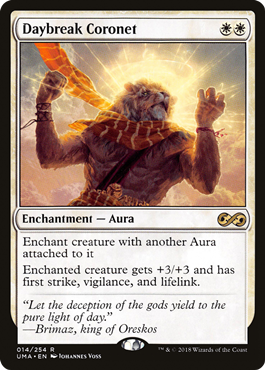Welcome back to another edition of “This Day in Magic History.” This time, we’re taking a look at the release of Coldsnap, which was released on July 21, 2006.
Coldsnap is one of the weirder black-bordered releases we’ve ever seen. It was printed as the intended third and final set of the Ice Age Block. That might not sound strange at first, but it gets weirder when you realize that Ice Age was originally released in June of 1995.

With such a huge gap between sets, let’s take a look at its development, reception and some of the important cards it produced. Plus, there’s currently an unbearable heat wave tearing up Oklahoma right now. Since the temperature has been more than 100 degrees Fahrenheit for most of July, it seemed like a good time to sit back and think about a set of eternal winter.

Mind the 10 year gap
Let’s start with a look at the impetus behind the creation of this unusual set. But before we can do that, it’s important to understand what a “Block” is, since we don’t see them anymore! For much of Magic’s history, sets were released using a “Block” schedule. This usually involved one large (300+ card) set and two smaller (ca. 150 cards) sets. These three sets were designed to be drafted together and there were also Block constructed formats.
One of the major motivations for a new set in Ice Age block was the epic failure of Homelands, which was originally the second set in Ice Age Block. This set is often considered the worst set ever, both in terms of design and the power level of the cards.
Mechanically, Homelands really didn’t feel like it was part of the same Block as Ice Age and Alliances. It was so bad that Wizards of the Coast Research and Development lobbied for the set not to be released at all. But once it did drop, it turned into a critical and financial failure.
Wizards of the Coast took a step back to think about future design and, as a result, this period was one of the biggest “make it or break it” moments in Magic’s history. There was a lot of concern about what might happen if they released a second, poorly received set. So, Wizards took their time with the next set, waiting an entire year before Alliances released in 1996.
In a lot of ways, Coldsnap was a do-over, and a way to sort of erase one of the most embarrassing sets in all of Magic history. This time, the set was designed so it would feel like it was actually part of the same Block as Ice Age and Alliances, but with 2006 design sensibilities.
By this point, many developers at Wizards of the Coast knew what made for a good and cohesive Block, something they still weren’t sure about back in 1996. After all, Ice Age Block was only the second Block they ever produced.
As a result of this approach, Wizards designed Coldsnap as a nostalgic set withmany callbacks to Ice Age and Alliances — as was typical of the second and third sets in Blocks.
A long winter for Limited
While Coldsnap was designed to be a third set in a Block, because Ice Age and Alliances were ten years old with dwindling supply, players couldn’t really hold Ice Age Block drafts. During the days of the Block release structure, once the third set of a Block came out, Draft consisted of one pack from each set. To compensate for this problem, players participated in triple Coldsnap drafts. This was a problem.
As I noted above, the set only has 155 cards in it, which is nowhere near enough cards for a good draft experience. For reference, a typical set release these days has 250+ cards. This difference in available options leads to you seeing the same cards far too often, and drafting Coldsnap quickly grew repetitive. This would have made Coldsnap a poor Limited format by itself. However, this problem was exacerbated by the Ripple mechanic, which appeared on a cycle of five Commons.

When you cast a card with Ripple, you look at the top four cards of your library and, if you hit any other cards with the same name as that card, you can cast it for free. Then, because that card has Ripple, you do it again.
In other words, Ripple allowed you to take advantage of the set’s extremely small card pool. And because they were Common cards and Limited only uses 40 card decks, it wasn’t unusual to cast a card with Ripple and hit several more.
If your opponent has four 2/1s with First Strike in play on turn three, you’re just not going to beat that. Basically, whoever went off with Ripple first won games in the format. Plus, if you didn’t manage to get several copies of one of the Ripple spells, it was very difficult to win at all. That wasn’t fun.
The good news is, if you play the actual Ice Age Block Limited format, things are much more balanced, since you only get one pack of Coldsnap.
Notable competitive cards from Coldsnap
Even though the set is quite small, Coldsnap has had a big impact on most of Magic’s constructed formats. In particular, I want to take a look at three cards from the set that ended up getting themselves (or cards they combo’d with) banned in at least one format: Rite of Flame, Counterbalance and Dark Depths. All three of these cards proved to be pretty broken when combined with another card from a different set.
Rite of Flame is a Red ritual effect. It checks the graveyards for other copies of the card, and you get an additional one Red mana for each other copy.
Like most ritual effects, Rite of Flame is great with Storm, and it found its earliest success in Standard Storm decks. However, it proved to be particularly powerful in Modern alongside Pyromancer Ascension.
Once you got it online, you could cast multiple copies of ritual effects, and this was extra strong with Rite of Flame. This combo could allow you to produce absolutely absurd amounts of mana. Rite of Flame was banned in Modern shortly after the format was created, and it remains banned in that format to this day.
Counterbalance is the kind of card that doesn’t seem particularly impressive when you first read it. Sure, it can counter spells for free, but only if the top card of your library has the same mana value as the spell your opponent casts.
Well, this was actually fairly easy to achieve with Sensei’s Divining Top, which allows you to manipulate the top of your library. This was especially powerful in Miracle decks in Legacy.
First, you already wanted the Top to manipulate your library so you could cast your Miracles for their discounted cost. Second, the format was primarily made up of lots of cards with mana values between 1 and 3, so you almost always had a card somewhere in the top three cards of your library that could counter your opponent’s spell. This powerful combo resulted in Sensei’s Divining Top getting banned in Extended, Legacy and Modern.
Dark Depths was a laughably bad card when it was originally printed in Coldsnap. Sure, you can eventually get a 20/20 with Flying and Indestructible in play, but you have to pay THIRTY mana to get there.
However, in 2009, Vampire Hexmage was printed. This allowed for a pretty powerful combo, since you could play the Mage and remove all the counters from Dark Depths, which quickly gave you that Marit Lage token.
This combo was successful in Extended first, but when the Modern format was created in 2011, Dark Depths was preemptively banned because the combo was so powerful. It remains banned in that format.
Dark Depths is also a central feature of Legacy Lands decks, which look to use Dark Depths alongside Vesuva.
Notable Commander cards from Coldsnap
In addition to impacting Magic’s premiere formats, there are also several cards from the set that see heavy play in Commander. There are two that I want to draw your attention to.
First, there’s Coldsteel Heart. Like most mana rocks that cost two mana, it sees a ton of play in Commander. It lets you choose a color when you play it, and it even comes with the Snow type if your deck is interested in that.
The most popular Commander from the set is Zur the Enchanter. This Esper Commander loves Enchantments with a mana value of three or less. Every time he attacks, you get to tutor one up and put it directly on the battlefield.
This means he can search up powerful cards like Rhystic Study and Necropotence, which is great. However, he can also do a whole lot of other interesting stuff.
You can go with more of a Voltron strategy, instead, and tutor up Auras that grow Zur or make it very difficult to kill him. This really allows you to snowball your way to victory with cards like Daybreak Coronet.
He can also search up a variety of different combos. For example, he can fetch both Solemnity and Phyrexian Unlife. The latter keeps you from losing the game for having 0 or less life.
This comes with the downside of making it so your opponent’s creatures effectively all have Infect. But with Solemnity in play, you can’t have poison counters put on you. So, you get all the upside of Unlife without the downside.
End step
I think I can pretty much guarantee we won’t ever see anything like Coldsnap ever again, and not just because we don’t have a Block release schedule anymore. It was a very strange concept. Can you imagine if in 2032 they release a new “Innistrad” set that replaces either Crimson Vow or Midnight Hunt? Yeah, me neither.
That does it for this week. Next week I’ll be back to discuss another important event in Magic history!

Jacob has been playing Magic for the better part of 24 years, and he especially loves playing Magic’s Limited formats. He also holds a PhD in history from the University of Oklahoma. In 2015, he started his YouTube channel, “Nizzahon Magic,” where he combines his interests with many videos covering Magic’s competitive history. When he’s not playing Magic or making Magic content, he can be found teaching college-level history courses or caring for a menagerie of pets with his wife.








